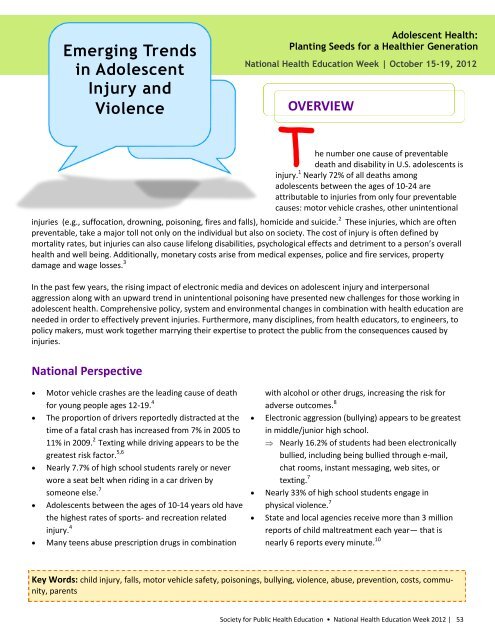Adolescent Health: Planting Seeds for a - Society for Public Health ...
Adolescent Health: Planting Seeds for a - Society for Public Health ...
Adolescent Health: Planting Seeds for a - Society for Public Health ...
You also want an ePaper? Increase the reach of your titles
YUMPU automatically turns print PDFs into web optimized ePapers that Google loves.
Emerging Trends<br />
in <strong>Adolescent</strong><br />
Injury and<br />
Violence<br />
<strong>Adolescent</strong> <strong>Health</strong>:<br />
<strong>Planting</strong> <strong>Seeds</strong> <strong>for</strong> a <strong>Health</strong>ier Generation<br />
National <strong>Health</strong> Education Week | October 15-19, 2012<br />
OVERVIEW<br />
T<br />
he number one cause of preventable<br />
death and disability in U.S. adolescents is<br />
injury. 1 Nearly 72% of all deaths among<br />
adolescents between the ages of 10-24 are<br />
attributable to injuries from only four preventable<br />
causes: motor vehicle crashes, other unintentional<br />
injuries (e.g., suffocation, drowning, poisoning, fires and falls), homicide and suicide. 2 These injuries, which are often<br />
preventable, take a major toll not only on the individual but also on society. The cost of injury is often defined by<br />
mortality rates, but injuries can also cause lifelong disabilities, psychological effects and detriment to a person’s overall<br />
health and well being. Additionally, monetary costs arise from medical expenses, police and fire services, property<br />
damage and wage losses. 3<br />
In the past few years, the rising impact of electronic media and devices on adolescent injury and interpersonal<br />
aggression along with an upward trend in unintentional poisoning have presented new challenges <strong>for</strong> those working in<br />
adolescent health. Comprehensive policy, system and environmental changes in combination with health education are<br />
needed in order to effectively prevent injuries. Furthermore, many disciplines, from health educators, to engineers, to<br />
policy makers, must work together marrying their expertise to protect the public from the consequences caused by<br />
injuries.<br />
National Perspective<br />
Motor vehicle crashes are the leading cause of death<br />
<strong>for</strong> young people ages 12-19. 4<br />
The proportion of drivers reportedly distracted at the<br />
time of a fatal crash has increased from 7% in 2005 to<br />
11% in 2009. 2 Texting while driving appears to be the<br />
greatest risk factor. 5,6<br />
Nearly 7.7% of high school students rarely or never<br />
wore a seat belt when riding in a car driven by<br />
someone else. 7<br />
<strong>Adolescent</strong>s between the ages of 10-14 years old have<br />
the highest rates of sports- and recreation related<br />
injury. 4<br />
Many teens abuse prescription drugs in combination<br />
with alcohol or other drugs, increasing the risk <strong>for</strong><br />
adverse outcomes. 8<br />
Electronic aggression (bullying) appears to be greatest<br />
in middle/junior high school.<br />
Nearly 16.2% of students had been electronically<br />
bullied, including being bullied through e-mail,<br />
chat rooms, instant messaging, web sites, or<br />
texting. 7<br />
Nearly 33% of high school students engage in<br />
physical violence. 7<br />
State and local agencies receive more than 3 million<br />
reports of child maltreatment each year— that is<br />
nearly 6 reports every minute. 10<br />
Key Words: child injury, falls, motor vehicle safety, poisonings, bullying, violence, abuse, prevention, costs, community,<br />
parents<br />
<strong>Society</strong> <strong>for</strong> <strong>Public</strong> <strong>Health</strong> Education • National <strong>Health</strong> Education Week 2012 | 53
















